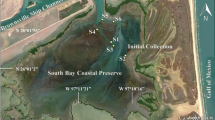Abstract
This study determined the rate at which nitrogen accumulated in seaweeds is released during decomposition and the effect of temperature on their rates of decomposition and nitrogen release. Gracilaria verrucosa and Ulva lactuca decomposed rapidly in outdoor mesocosms. Ulva, but not Gracilaria, became nitrogen-enriched during decomposition. Maximal weekly rates of nitrogen release were 5.91 ± 2.23 and 6.37 ± 2.59 g N m−2 d−1, respectively for Gracilaria and Ulva. Temperature had a significant effect on the decomposition rate of Gracilaria in a laboratory experiment: decomposition was greater at 30 °C than at 25 °C. No net decomposition was observed at 16 °C. Gracilaria became nitrogen enriched at 30 °C, but not at 16° or 25°. The release of stored nutrients from decaying seaweeds should be included in nutrient budgets and models when seaweed standing stocks are significant. Seaweed source-sink relationships are important ecologically and can be applied to attempts at using seaweeds as environmental monitors of anthropogenic eutrophication and to efforts of cultivating seaweeds for the improvement of water quality.
Similar content being viewed by others
References
Buchsbaum R, Valiela I, Swain T, Dzierzeski M, Allen S (1991) Available and refractory nitrogen in detritus of coastal vascular plants and macroalgae. Mar. Ecol. Progr. Ser. 72: 131–143.
Chapman ARO, Craigie JS (1977) Seasonal growth in Laminaria longicruris: Relations with dissolved inorganic nutrients and internal reserves of nitrogen. Mar. Biol. 40: 197–205.
Dawes CJ (1985) Macroalgae of the Tampa Bay Estuarine System. In Treat SF, Simon JL, Lewis RR III, Whitman RL Jr (eds), Proceedings Tampa Bay Area Scientific Information Symposium. Bellwether Press, Tampa, 184–209.
Dawes CJ, Bird KT, Durako M, Goddard R, Hoffman W, McIntosh R (1979) Chemical fluctuations due to seasonal and cropping effects on an algal-seagrass community. Aquat. Bot. 6: 79–86.
Habig C, Ryther JH (1984) Some correlations between substrate compositions and biogas yields. Symposium Papers, Energy from Biomass and Waste, Institute of Gas Technology, Chicago. 8: 817–832.
Habig C, DeBusk TA, Ryther JH (1984) The effect of nitrogen content on methane production by the marine alga Gracilaria tikvahiae and Ulva sp. Biomass 4: 239–251.
Hanisak MD (1979) Nitrogen limitation of Codium fragile ssp. tomentosoides as determined by tissue analysis. Mar. Biol. 50: 333–337.
Hanisak MD (1983) The nitrogen relationship of marine macroalgae. In Carpenter EJ, Capone DG (eds), Nitrogen in the Marine Environment. Academic Press, New York, 699–730.
Hanisak MD (1987) Cultivation of Gracilaria and other macroalgae in Florida for energy production. In Bird KT, Benson PH (eds), Seaweed Cultivation for Renewable Resources. Elsevier, New York, 191–218.
Hanisak MD (1990) The use of Gracilaria tikvahiae (Gracilariales, Rhodophyta) as a model system to understand the nitrogen nutrition of cultured seaweeds. In Lindstrom SC, Gabrielson PW (eds), Thirteenth International Seaweed Symposium, Developments in Hydrobiology 58. Kluwer Academic Publishers, Dordrecht, 79–87. Reprinted from Hydrobiologia 204/205.
Lapointe BE, Littler MM, Littler DS (1992) Nutrient availability to marine macroalgae in siliciclastic versus carbonate-rich waters. Estuaries 15: 75–82.
Lavery PS, McComb AJ (1991) Macroalgal-sediment nutrient interactions and their importance to macroalgal nutrition in a eutrophic estuary. Est. Coast. Shelf Sci. 32: 281–295.
Owens NJP, Stewart WDP (1983) Enteromorpha and the cycling of nitrogen in a small estuary. Est. Coast. Shelf Sci. 17: 287–296.
Ryther JH, Corwin N, DeBusk TA, Williams LD (1981) Nitrogen uptake and storage by the red alga Gracilaria tikvahiae (McLachlan, 1979). Aquaculture 26: 107–115.
Sfriso A, Marcomini A, Pavoni B (1987) Relationships between macroalgal biomass and nutrient concentrations in a hypertrophic area of the Venice Lagoon. Mar. Env. Res. 22: 297–312.
Virnstein RW, Carbonara PA (1985) Seasonal abundance and distribution of drift algae and seagrasses in the mid-Indian River Lagoon, Florida. Aquat. Bot. 23: 67–82.
Wheeler PA, Björnsäter BR (1992) Seasonal fluctuations in tissue nitrogen, phosphorus, and N:P for five macroalgal species common to the Pacific Northwest Coast. J. Phycol. 28: 1–6.
Williams SL (1984) Decomposition of the tropical macroalga Caulerpa cupressoides (West) C. Agardh: field and laboratory studies. J. exp. mar. Biol. Ecol. 80: 109–124.
Author information
Authors and Affiliations
Rights and permissions
About this article
Cite this article
Hanisak, M.D. Nitrogen release from decomposing seaweeds: species and temperature effects. J Appl Phycol 5, 175–181 (1993). https://doi.org/10.1007/BF00004014
Issue Date:
DOI: https://doi.org/10.1007/BF00004014




